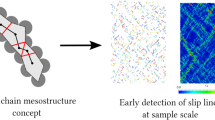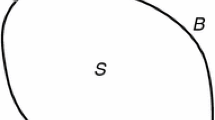Abstract
In this paper, we report a set of experiments performed on a novel mechanical device that allows a specimen composed of a two-dimensional opaque granular assembly to be subjected to quasi-static shear conditions. A complete description of the grain-scale quantities that control the mechanical behavior of granular materials is extracted throughout the shear deformation. Geometrical arrangement, or fabric, is quantified by means of image processing, grain kinematics are obtained using Digital Image Correlation and contact forces are inferred using the Granular Element Method. Aiming to bridge the micro-macro divide, macroscopic average stresses for the granular assembly are calculated based on grain-scale fabric parameters and contact forces. The experimental procedure is detailed and validated using a simple uniaxial compression test. Macroscopic results of shear stress and volumetric strain exhibit typical features of the shear response of dense granular materials and indicate that critical state is achieved at large deformations. At the grain scale, attention is given to the evolution of fabric and contact forces as the granular assembly is sheared. The results show that shear deformation induces geometrical (fabric) and mechanical (force) anisotropy and that principal stresses and force orientation rotate simultaneously. At critical state, stress, force and fabric orientation reach the same value. By seamlessly connecting grain-scale information to continuum scale experiments, we shed light into the multiscale mechanical behavior of granular assemblies under shear loading.










Similar content being viewed by others
References
Bardet, J.-P.: Experimental Soil Mechanics. Prentice Hall, Upper Saddle River (1997)
Bishop, A.W., Henkel, D.J.: The Measurement of Soil Properties in the Triaxial Test. Hodder Arnold H&S, London (1970)
Kjellman, W.: Testing the shear strength of clay in Sweden. Gotechnique 2, 225–232 (1951)
Roscoe, K.H.: An apparatus for the application of simple shear to soil samples. In: Proceedings of 3rd International Conference on Soil Mechanics Foundation Engineering, Zurich, pp. 186–191 (1953)
Casagrande, A.: Characteristics of cohesionless soils affecting the stability of slopes and earth fills. J. Boston Soc. Civil Eng. (1936)
Roscoe, K.H., Schofield, A.N., Wroth, C.P.: On the yielding of soils. Gotechnique 8, 22–53 (1958)
Schofield, A.N., Wroth, P.: Critical State Soil Mechanics. McGraw-Hill Book Co., London (1968)
Parry, R.H.G.: Stress–Strain Behavior of Soils. G.T. Foulis and Co., Henley (1972)
Muir Wood, D.: Soil Behavior and Critical State Soil Mechanics. Cambridge University Press, Cambridge (1990)
Rowe, P.W.: The stress-dilatancy relation for static equilibrium of an assembly of particle in contact. Proc R. Soc. A 269, 500–527 (1962)
Oda, M., Nemat-Nasser, S., Konishi, J.: Stress-induced anisotropy in granular masses. Soils Found. 25, 85–97 (1985)
Thornton, C.: Induced anisotropy and energy dissipation in particulate material—results from computer-simulated experiments. In: Yielding, Damage, and Failure of Anisotropic Solids. Mechanical Engineering Publications, London, pp. 113–130 (1990)
Majmudar, T.S., Behringer, R.P.: Contact force measurements and stress-induced anisotropy in granular materials. Nature 435, 1079–1082 (2005)
Rothenburg, L., Bathurst, R.J.: Analytical study of induced anisotropy in idealized granular materials. Geotechnique 39, 601–614 (1989)
Ouadfel, H., Rothenburg, L.: Stress–force–fabric relationship for assemblies of ellipsoids. Mech. Mater. 33, 201–221 (2001)
Cundall, P.A., Strack, O.D.L.: A discrete numerical model for granular assemblies. Gotechnique 29, 47–65 (1979)
Masson, S., Martinez, J.: Micromechanical analysis of the shear behavior of a granular material. J. Eng. Mech. 127, 1007–1016 (2001)
Thornton, C.: Numerical simulations of deviatoric shear deformation of granular media. Gotechnique 50, 43–53 (2000)
Cui, L., O’Sullivan, C.: Exploring the macro- and micro-scale response of an idealised granular material in the direct shear apparatus. Gotechnique 56, 455–468 (2006)
Fu, P., Dafalias, Y.F.: Fabric evolution within shear bands of granular materials and its relation to critical state theory. Int. J. Numer. Anal. Methods Geomech. 35, 1918–1948 (2011)
Calvetti, F., Combe, G., Lanier, J.: Experimental micromechanical analysis of a 2D granular material: relation between structure evolution and loading path. Mech. Cohesive Frict. Mater. 2, 121–163 (1997)
Matsuoka, H.: A microscopic study of shear mechanism of granular materials. Soils Found. 14, 29–43 (1974)
Oda, M., Konishi, J.: Rotation of principal stresses in granular material during simple shear. Soils Found. 14, 39–53 (1974)
Oda, M., Konishi, J.: Microscopic deformation mechanism of granular material in simple shear. Soils Found. 14, 25–38 (1974)
Howell, D., Behringer, R.P.: Stress fluctuations in a 2D granular Couette experiment: a continuous transition. Phys. Rev. Lett. 82, 5241 (1999)
Hall, S.A., Desrues, J., Viggiani, G., Besuelle, P., Ando, E.: Experimental characterisation of (localised) deformation phenomena in granular geomaterials from sample down to inter- and intra-grain scales. Procedia IUTAM 4, 54–65 (2012)
Hall, S., Wood, D.M., Ibraim, E., Viggiani, G.: Localised deformation patterning in 2D granular materials revealed by digital image correlation. Granul. Matter 12, 1–14 (2009)
Vitone, C., Viggiani, G., Cotecchia, F., Hall, S.A.: Localized deformation in intensively fissured clays studied by 2D digital image correlation. Acta Geotech. 8, 247–263 (2013)
Rechenmacher, A.L.: Grain-scale processes governing shear band initiation and evolution in sands. J. Mech. Phys. Solids 63, 154–166 (2005)
Pan, B., Qian, K., Xie, H., Asundi, A.: Robust full-field measurement considering rotation using digital image correlation. Meas. Sci. Technol. 20, 062001 (2009)
Sutton, M.A., Orteu, J.J., Schreier, H.: Image Correlation for Shape, Motion and Deformation Measurements: Basic Concepts, Theory and Applications. Springer, USA (2009)
Drescher, A.: Photoelastic verification of a mechanical model for the flow of a granular material. J. Mech. Phys. Solids 20, 337–340 (1972)
Andrade, J.E., Avila, C.F.: Granular element method (GEM): linking inter-particle forces with macroscopic loading. Granul. Matter 14, 51–61 (2012)
Hurley, R.C., Marteau, E., Ravichandran, G., Andrade, J.E.: Extracting inter-particle forces in opaque granular materials: beyond photoelasticity. J. Mech. Phys. Solids 63, 154–166 (2014)
Hurley, R.C., Lim, K.W., Ravichandran, G., Andrade, J.E.: Dynamic inter-particle force inference in granular materials: method and application. Exp. Mech. 56, 217–229 (2016)
Karanjgaokar, N.: Evaluation of energy contributions using inter-particle forces in granular materials under impact loading. Granul. Matter 19, 36 (2017)
Hurley, R.C., Hall, S.A., Andrade, J.E., Wright, J.: Quantifying interparticle forces and heterogeneity in 3D granular materials. Phys. Rev. Lett. 117, 098005 (2016)
Ballard, D.H.: Generalizing the Hough transform to detect arbitrary shapes. Pattern Recognit. 13, 111–122 (1981)
Peng, T.: Detect circles with various radii in grayscale image via hough transform. http://www.mathworks.com/matlabcentral/fileexchange (2010)
Doyle, J.F.: Manual on experimental stress analysis. Society for Experimental Mechanics (1989)
Christoffersen, J., Mehrabadi, M.M., Nemat-Nasser, S.: A micromechanical description of granular material behavior. J. Appl. Mech. 48, 339–344 (1981)
Timoshenko, S., Goodier, J.N.: Theory of Elasticity. McGraw-Hill Book Co, New York (1951)
Frocht, M.M.: Photoelasticity. Wiley, New York (1941)
Daniels, K.E., Kollmer, J.E., Puckett, J.G.: Photoelastic force measurements in granular materials. https://arxiv.org/abs/1612.03525 (2016)
Surendra, K.V.N., Simha, K.R.Y.: Characterizing frictional contact loading via isochromatics. Exp. Mech. 54, 1011–1030 (2014)
Roscoe, K.H., Bassett, R.H., Cole, E.R.L.: Principal axes observed during simple shear of a sand. In: Proceedings of Geotechnical Conference, Oslo, pp. 231–237 (1967)
Radjai, F., Wolf, D.E., Jean, M., Moreau, J.J.: Bimodal character of stress transmission in granular packing. Phys. Rev. Lett. 80, 61–64 (1998)
Reinsch, C.H.: Smoothing by spline functions. Numer. Math. 10, 177–183 (1967)
Acknowledgements
This work was supported in part by the Defense Threat Reduction Agency (DTRA) under award number HDTRA1-12-1-0041. This support is gratefully acknowledged.
Author information
Authors and Affiliations
Corresponding author
Ethics declarations
Conflict of interest
No potential conflict of interest is reported by the authors. None of the material presented in the paper is submitted or published elsewhere, and the paper does not contain any information with restricted access or proprietary content.
Appendix: The granular element method
Appendix: The granular element method
In this appendix, we describe the GEM algorithm in a pseudo-code format. Let \(i_p\) and \(i_\alpha \) denote the storage indices for, respectively, the p-th particle and the \(\alpha \)-th contact, for \(\alpha \in \{1,\ldots ,N_c\}\) and \(p \in \{1,\ldots ,N_p\}\). \(N_p\) is the total number of grains and \(N_c\) is the total number of contact. For more details on the mathematical framework of GEM, see [33,34,35].
Inputs: | Position of contact points \(\varvec{x} = [\varvec{x}^1,\varvec{x}^2,\ldots ,\varvec{x}^{_{N_c}}]^T\) where \(\varvec{x}^{\alpha } = \{ x^{\alpha },y^{\alpha } \}\) |
Average grain stress \(\bar{\varvec{\sigma }} = [\bar{\varvec{\sigma }}^1,\bar{\varvec{\sigma }}^2,\ldots ,\bar{\varvec{\sigma }}^{_{N_p}}]^T\) where \(\bar{\varvec{\sigma }}^{p} = \{\bar{\sigma }^p_{xx}, \bar{\sigma }^p_{yy}, \bar{\sigma }^p_{xy} \}\) | |
Surface of grains \(\Omega = [\Omega _1,\Omega _2,\ldots ,\Omega _{_{N_p}}]^T\) | |
Normal unit contact vector \(\varvec{e} = [\varvec{e}^1,\varvec{e}^2,\ldots ,\varvec{e}^{_{N_c}}]^T\) where \(\varvec{e}^{\alpha } = \{ e_x^{\alpha },e_y^{\alpha } \}\) | |
Tangential unit contact vector \(\varvec{t} = [\varvec{t}^1,\varvec{t}^2,\ldots ,\varvec{t}^{_{N_c}}]^T\) where \(\varvec{t}^{\alpha } = \{ t_x^{\alpha },t_y^{\alpha } \}\) | |
Inter-particle friction coefficient \(\mu \) | |
Boundary of granular assembly \(\Gamma \) | |
Output: | Force vector \(\varvec{f} = [\varvec{f}^1,\varvec{f}^2,\ldots ,\varvec{f}^{_{N_c}}]^T\) where \(\varvec{f}^{\alpha } = \{ f_x^{\alpha },f_y^{\alpha } \}\) |

Rights and permissions
About this article
Cite this article
Marteau, E., Andrade, J.E. A novel experimental device for investigating the multiscale behavior of granular materials under shear. Granular Matter 19, 77 (2017). https://doi.org/10.1007/s10035-017-0766-x
Received:
Published:
DOI: https://doi.org/10.1007/s10035-017-0766-x




